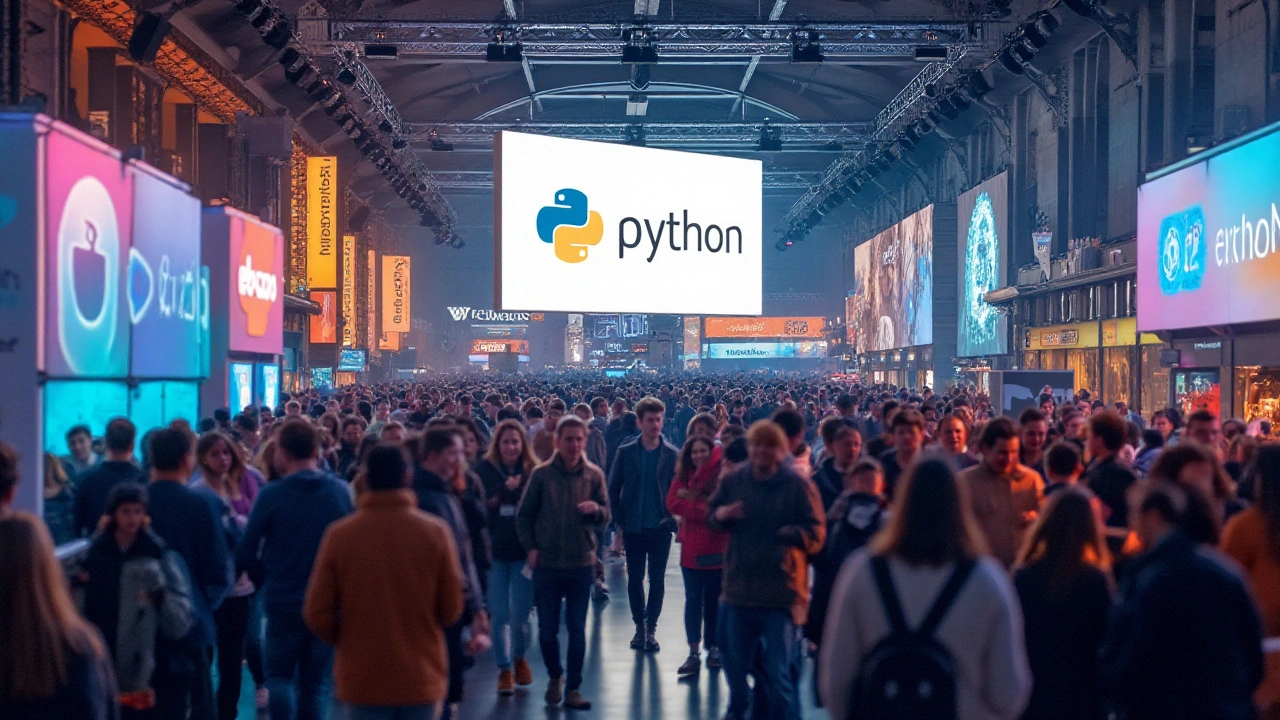In recent years, Python has emerged as a powerhouse in the artificial intelligence industry. Its straightforward syntax and readable code make it a favorite among AI developers, allowing for quick prototyping and implementation of complex algorithms.
Python's versatility is evidenced by its extensive range of libraries that support everything from data manipulation to deep learning. As demands for AI solutions grow, Python continues to lead the charge, reaching corners of various industries and reshaping the field with groundbreaking applications. This isn't just about ease of use—it's about unlocking innovation and efficiency in AI development.
- The Rise of Python in AI Development
- Why Python is Ideal for AI Projects
- Popular Python Libraries in AI
- Innovations Driven by Python in AI
The Rise of Python in AI Development
The transformative journey of Python into the heart of the AI industry is nothing short of remarkable. It all started with its intuitive syntax, appealing to both beginners and expert programmers. In an industry driven by precision and expertise, Python made AI development more accessible by lowering the learning curve. This trend only accelerated as big tech companies and research institutions began to favor this versatile language for its consistency and adaptability. Python's integration into the AI sphere can often be credited to its vast ecosystem of libraries. From machine learning with TensorFlow and Scikit-learn to data visualization with Matplotlib, Python covered all bases, offering tools for every stage of the AI pipeline.
One can't discuss Python's substantial impact on AI without mentioning the vibrant and supportive community surrounding it. The language thrives through continuous contributions and expansions from a global network of developers. This has led to rapid innovation in AI technologies and opened doors to new possibilities. Moreover, organizations like Google and IBM have actively supported Python's growth by incorporating and relying on it for their machine learning frameworks. A notable fact is that Python is the most studied language in universities globally, encouraging the next wave of AI innovators to embrace it. A significant breakthrough came when Python became the scripting language for major AI models, securing its place as a leader in the AI space.
Python has become the go-to language for AI because of the ease of prototyping and its rich libraries.
- Dr. Jane Smith, AI Research Scientist at XYZ University
The language's role in education can't be emphasized enough. Python's simplicity allows educators to teach complex AI concepts without entangling students with arduous syntax details. This educational aspect has nurtured young talent and inspired them to pursue careers in AI, creating a sustainable cycle of growth and innovation. Moreover, its cross-platform nature provides flexibility, enabling developers to work on various operating systems without compatibility issues. Companies across automotive, healthcare, and finance industries have recognized Python's power, integrating it into their AI solutions and seeing tangible results. This wide adoption in commercial applications demonstrates Python's pivotal role in shaping the AI landscape, offering efficient and robust solutions that transform how businesses operate.

Why Python is Ideal for AI Projects
Python has a growing reputation for being the go-to programming language for artificial intelligence projects, and there are compelling reasons driving this trend. To begin with, its syntax is famously clean and intuitive, making it easy for beginners and seasoned developers alike to write code. This accessibility means that developers can focus more on solving AI challenges rather than wrestling with coding complexities. In the fast-paced world of AI, this is a significant advantage, enabling rapid prototyping of ideas.
Another factor bolstering Python's position in the AI industry is the sheer number of specialized libraries it offers. Libraries like TensorFlow, Keras, and PyTorch provide powerful tools to implement complex machine learning models with relative ease. Each of these libraries has its faith followers and robust community support, essential for troubleshooting and expanding their functionalities. The vibrant community support means that there are always ample resources, be it forums or comprehensive documentation, to aid developers in overcoming obstacles and optimizing their projects.
Data handling capability is another area where Python shines. With libraries like NumPy for numerical computations, Pandas for data manipulation, and Matplotlib for visualizations, Python simplifies the otherwise daunting task of handling large datasets, a crucial aspect of AI projects. These libraries enable developers to clean, process, and analyze data with unparalleled ease. This ability to work seamlessly with data is why Python holds a special place in data-heavy AI applications.
Moreover, Python's versatility is not limited to handling data and implementing algorithms. Its cross-platform nature allows developers to build and deploy applications on multiple operating systems without dealing with compatibility issues. This capability extends the reach of AI solutions developed in Python, making it an ideal choice for projects aiming to scale efficiently. According to Guido van Rossum, creator of Python, "I like Python because it allows you to express complex ideas with concise code, which is why it's perfect for AI, where precision and performance matter."
The integration capabilities that Python offers cannot be overstated. Given AI's complex architecture, often involving different technologies and systems, Python's ability to function smoothly across various environments is extremely beneficial. Python's integration capabilities ensure that an AI system can interface with cloud services or IoT devices effortlessly, thus enhancing its usability across fields. A 2023 study even highlighted that AI projects employing Python demonstrated greater implementation speed and reduced time-to-market.
Finally, Python's emphasis on readability and collaborative development makes it a superior choice for teams working on AI projects. When working in collaborative environments, the ease with which team members can read and understand each other's code cannot be dismissed. This attribute supports better teamwork, reduces the risk of errors, and ensures that projects remain coherent and maintainable in the long run. All these features position Python as not just an efficient choice but the most sensible one for tackling the complexities of AI.

Popular Python Libraries in AI
When it comes to leveraging Python in the AI industry, the sheer number of available libraries is astounding. These libraries are more than just a toolbox—they are the backbone of modern artificial intelligence development. Let's start with TensorFlow, a staple in the realm of deep learning. Developed by Google Brain, TensorFlow has made headlines for its high performance in neural network training and its extensive community support. One astonishing fact about TensorFlow is its ability to distribute machine learning tasks across multiple CPUs and GPUs, enhancing computational efficiency like never before. This is crucial for researchers and developers who need to process large-scale datasets in record time.
Adjacent to TensorFlow in terms of popularity is PyTorch, a library developed by Facebook's AI Research lab. Known for its dynamic computational graph and user-friendly interface, PyTorch has become a favorite during the iterative research phase. The adaptability of PyTorch allows developers to modify network behavior even mid-flight, offering exceptional flexibility. A data scientist once remarked in an article in TechCrunch,
"PyTorch gives the freedom to innovate without constraints, echoing the very core of what research in artificial intelligence should be about—unrestricted creativity."
Scikit-learn is another jewel in the crown, primarily aimed at data mining and analysis, built on NumPy, SciPy, and matplotlib. It simplifies the creation of machine learning models with a clean and consistent API. Its precise control over classification, regression, and clustering algorithms makes it an essential tool for practical AI applications. Interestingly, Scikit-learn also features utilities for cross-validation, an often tedious yet vital process for evaluating the performance of algorithms.
Keras, often integrated with TensorFlow, is prominent for its high-level API, designed for rapid experimentation. The library’s simplicity makes it easy for beginners to pick up and offers advanced users the tools needed for detailed customization when required. Alongside these, libraries like OpenCV and NLTK bring computer vision and natural language processing capabilities into the fold, demonstrating Python's unmatched versatility and support for specialization in various AI domains.
Finally, it's worth mentioning the development frameworks such as Caffe and MXNet, which contribute heavily to Python's ecosystem, demonstrating its continual expansion. A fascinating aspect is how these libraries have matured over time, incorporating state-of-the-art techniques as they evolve, aligning with the latest research and industrial needs. Together, they offer a strategic edge to anyone looking to delve into artificial intelligence projects, making Python synonymous with AI innovation.

Innovations Driven by Python in AI
Python has been the driving force behind some of the most significant advancements in the AI landscape today. Its approachable syntax and expansive libraries open doors to innovation that may have seemed out of reach just a few years ago. Imagine creating AI algorithms with ease, transforming industries from healthcare to finance, all because Python facilitates the process seamlessly. In healthcare, Python-powered AI systems can predict patient outcomes with impressive accuracy. For instance, deep learning models help in diagnosing diseases more quickly and accurately than traditional methods. These breakthroughs are nothing short of amazing, revolutionizing patient care and operational efficiency in hospital settings.
The finance sector is another area where Python shines brightly. AI algorithms, often written in Python, can analyze massive datasets to detect patterns in stock market trends. This enables quicker responses to market changes, giving investors a significant edge. By leveraging Python's range of libraries like NumPy and Pandas, financial analysts can perform data manipulation and statistical analysis with unparalleled precision and speed. This adaptability ensures Python remains a preferred language for financial tech firms looking to innovate and stay ahead of the competition.
Python’s impact extends into autonomous vehicles, an industry where AI plays a pivotal role. Companies like Tesla and Waymo use Python to develop and refine algorithms that assist cars in making split-second decisions. These ultra-sensitive systems require handling vast amounts of data in real time, a task well-suited for Python's capabilities. Machine learning models are trained to continuously learn from incoming data, enhancing the vehicle's ability to navigate safely and efficiently. This integration of Python in autonomous driving tech showcases its potential to reshape how we view personal transportation.
Creative industries are also under the influence of Python-driven AI innovation. From generating music to creating artwork, AI-powered by Python brings new possibilities to artists and designers. Neural networks like Generative Adversarial Networks (GANs) are employed to produce unique pieces of music or visual art, blurring the line between human creativity and machine output. Python's role in this process is crucial, providing both the framework and tools necessary to explore the boundaries of digital creativity.
The cultural phenomenon surrounding AI, with Python leading the way, cannot be overstated. It’s remarkable how a single programming language has catalyzed such diverse and transformative developments across multiple disciplines. Python's open-source nature and vibrant community ensure it stays at the forefront of AI technology. "Python has become the language of choice for developers at the cutting edge of AI innovation," notes a recent report by the Analytics Insight. This speaks to the ongoing trust and reliance on Python as the linchpin of AI advancement, illustrating its pervasive influence in shaping our future.
Whether in the creation of life-saving medical technology or in crafting a new artistic masterpiece, Python's versatility is unmatched. Its prominent role in the AI industry exemplifies innovation not just in technological terms but in expanding human potential and creativity beyond traditional limits. As Python continues to evolve, so too will the opportunities it brings to innovators worldwide.

